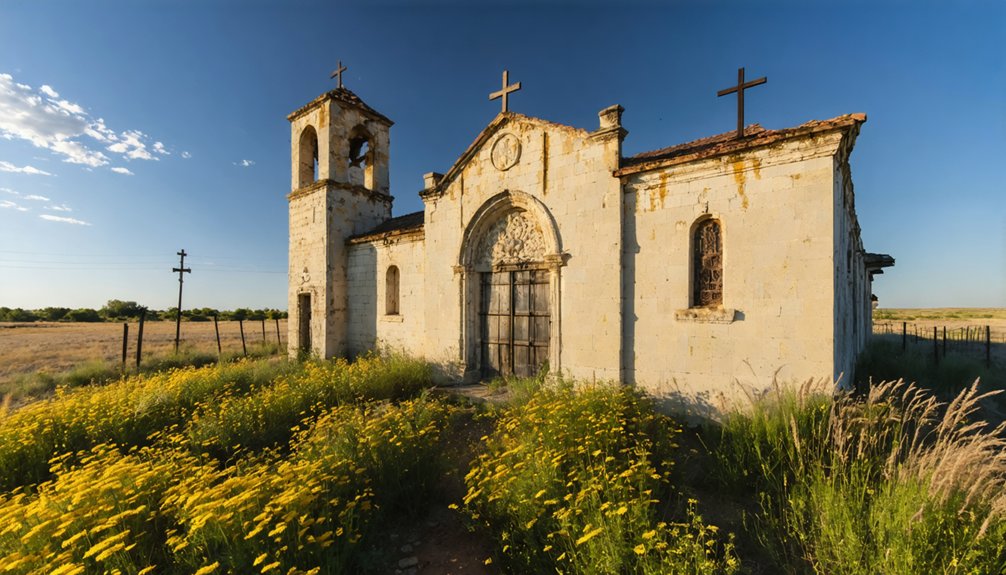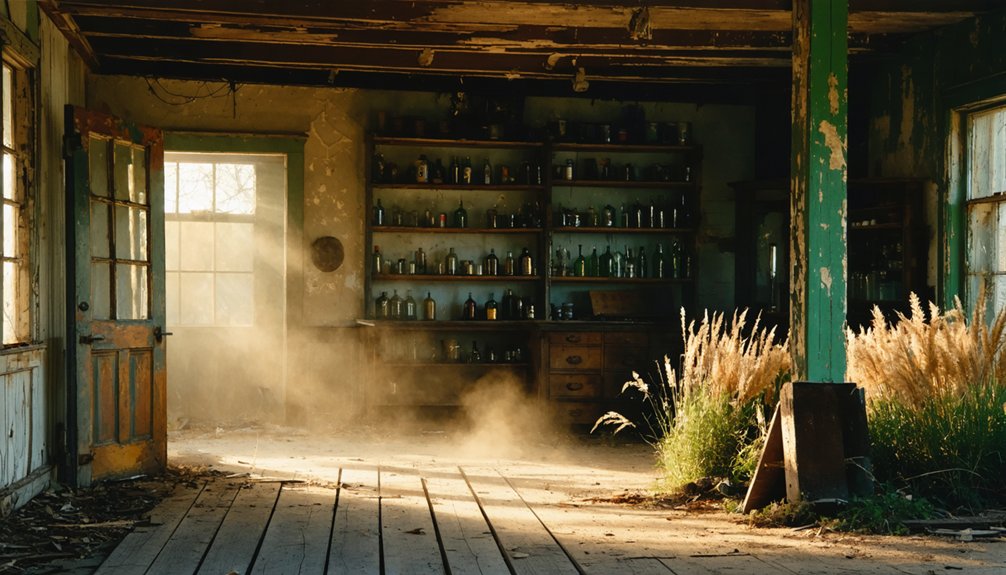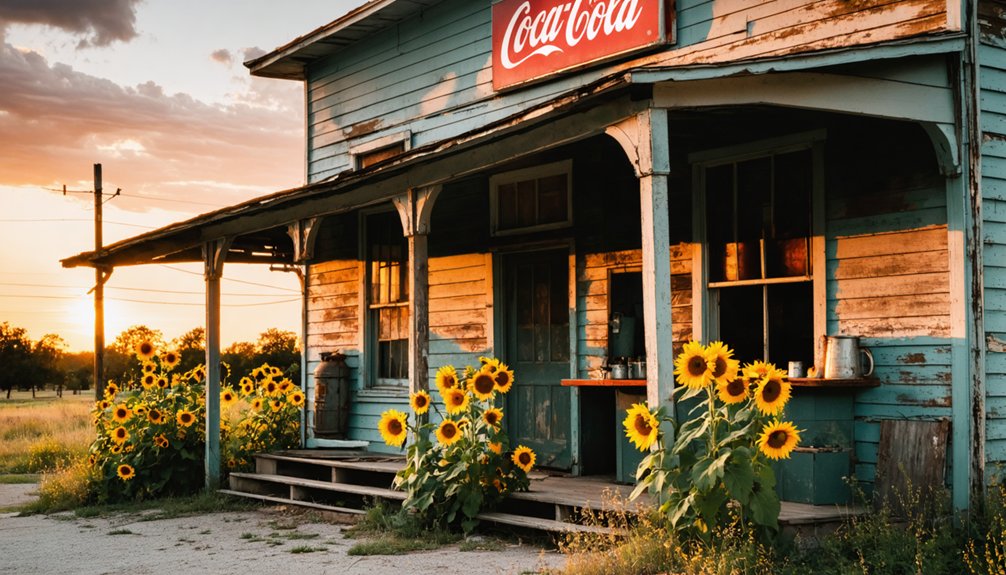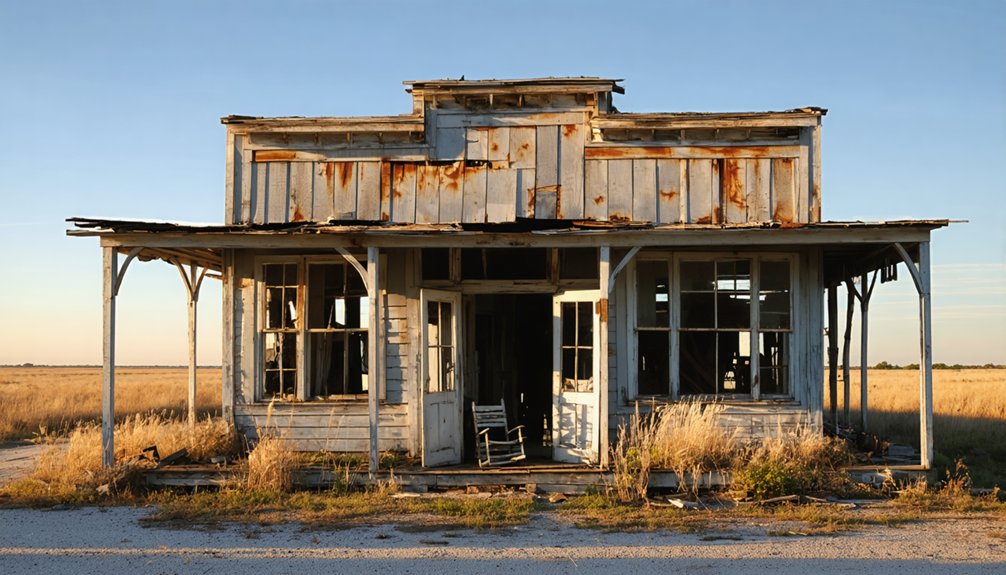You’ll find Kicaster at the junction of New Sulphur Springs Road and County Road 324 in Wilson County, Texas. This post-Civil War settlement, formally named in 1888, once thrived with pioneer families like the Crows, Pettis, and Watkins. The community boasted a successful school with 49 students by 1896, but gradually declined as younger residents moved to cities. Today, only weathered foundations and scattered remnants hint at the rich stories of frontier life waiting to be discovered.
Key Takeaways
- Kicaster emerged as a post-Civil War settlement in Wilson County, Texas, but declined in the early 20th century as residents moved to cities.
- The community developed around the Union School Community plot in 1872, with a school enrolling 49 students by 1896.
- Located at New Sulphur Springs Road and County Road 324, Kicaster was established by pioneer families including Crow, Pettis, and Watkins.
- Economic hardships, changing transportation routes, and population migration led to business closures and community fragmentation.
- Today, Kicaster exists primarily as a ghost town in southeastern Texas Hill Country, marked by its ranching and farming heritage.
Origins of the Kicaster Name and Settlement
Kicaster, Texas emerged as a post-Civil War settlement in northwestern Wilson County, formally adopting its distinctive name in August 1888. While the Kicaster etymology remains undocumented in historical records, the name change marked an important step in community recognition during the late 19th century.
Unlike Oatmeal and Nameless, which had challenges receiving post office approval, Kicaster’s development followed different patterns than nearby German-influenced settlements. Unlike many Wilson County towns named after prominent families or European locations, Kicaster’s name origin remains a mystery – it’s not clearly tied to any family name, geographical feature, or Native American term. Much like the rich heritage of Texas itself, the town’s history represents an important piece of the state’s diverse past.
The settlement quickly established itself, and by 1896, you could find a thriving school with forty-nine students, demonstrating the community’s rapid growth and commitment to education. Similar to Grapetown, the community relied heavily on local farmers and teamsters for its economic foundation.
Early Pioneer Families and Community Formation
The first pioneer families began settling in Kicaster during the 1850s, with prominent names like Isaac Crow, Gilbert Pettis, and John Watkins establishing homesteads in what would become Wilson County.
You’ll find these early settlers faced considerable challenges, including Native American hostilities and isolation, as they worked to build basic infrastructure and agricultural operations in the frontier environment. Similar to the tragic events of the Goer family attack, settlers had to remain vigilant against raids while trying to establish their new homes. Many communities like Kicaster faced situations reminiscent of Confederate troops patrolling against hostile tribes.
The growing ranching community formed strong social bonds through shared hardships and cooperation, with extended family networks playing an essential role in survival and development during those formative years.
First Settlers’ Arrival
Following the Civil War’s conclusion, pioneer families established Kicaster as a rural settlement in northwestern Wilson County, Texas. You’ll find these early settlers faced typical frontier challenges while carving out their homesteads from untamed land, dealing with community isolation and limited infrastructure.
These determined families chose their location strategically, settling near what would become Farm Road 3432, ensuring future access to essential trade routes. They quickly got to work clearing land for farming and ranching operations, building scattered homesteads around what would become the community’s center. Like many communities that would later face water shortages, they carefully considered their settlement’s location near reliable water sources. Like the resilient residents of Sagrado Corazon church, they built a strong spiritual foundation for their growing community.
Despite the hardships, they prioritized education early on, and by 1896, you could find 49 students enrolled in the local school. Their commitment to education demonstrated their vision for creating a sustainable, family-oriented community.
Influential Founding Families
Pioneer families like Isaac Crow, Gilbert Pettis, and the Watkins brothers formed Kicaster’s influential founding core during the 1850s and beyond.
You’ll find the fingerprints of these founding families on every aspect of early community life, from Thomas P. Camp and Dr. W.R. Callaway’s leadership to Isom Ferguson’s contributions to local development.
Community builders like Ira Anderson, Robert Spivey, and Lemon Pittman helped establish essential institutions that shaped Kicaster’s growth.
Together with Daniel B. Lay and J.J. Moore, they created the framework for schools, churches, and businesses that would serve nearly 50 students by 1896.
These visionary settlers worked through the Wilson County Commissioner’s Court to establish roads, voting systems, and postal routes, connecting their fledgling community to San Antonio and surrounding settlements.
The community’s identity began taking shape when residents gathered at the Union School Community plot established in 1872.
Like the mining town of Shafter, the community provided medical care and housing to support the basic needs of its growing population.
Ranching Community Takes Shape
While these founding families laid the groundwork for Kicaster’s development, a vibrant ranching community emerged in the 1860s through pioneering agricultural efforts.
You’ll find that the area’s ranching roots drew from a rich blend of Hispanic vaquero traditions and Anglo cattle herding practices, creating a distinctive local culture. The community thrived by adapting traditional agricultural practices to the region’s conditions, with families establishing mixed farming and ranching operations. Following the U.S. annexation of Texas, local ranchers benefited from growing economic demand for cattle and new market opportunities.
Transportation routes played a significant role in your ancestors’ success, as newly developed roads like the Sulphur Springs Road connected ranchers to essential markets in San Antonio. John James donated land in 1872 to establish a schoolhouse that became central to the community’s growth.
These pathways formed an important network for moving cattle and crops, while the Union School and local churches strengthened the bonds between farming families who worked the land.
Geographic Features and Natural Landscape
Nestled at the junction of New Sulphur Springs Road and County Road 324 in Wilson County, Kicaster occupies a distinctive position within the southeastern Texas Hill Country‘s transformation zone.
You’ll find this historic settlement within a small sandy watershed of Kicaster Creek, where the land use patterns reflect generations of ranching and farming heritage.
The area’s soil types, primarily sandy loam and alluvial deposits, have long supported agriculture and grazing. Native grasses, oak and mesquite woodlands dot the gently rolling terrain, while the creek’s seasonal flows shape the local landscape.
The watershed’s natural drainage system creates fertile conditions near the creek beds, where riparian plant communities thrive. This strategic location near reliable water sources made Kicaster an attractive spot for early settlers seeking agricultural opportunities.
Spanish Colonial Influence and Heritage

You’ll find Kicaster’s Spanish colonial roots in its very name, bestowed by early Spanish explorers who first mapped and used these lands as part of their mission ranching territories.
The area’s waterways, including Kicaster Creek, were carefully documented by Spanish expeditions as they established a network of mission-controlled ranches throughout the region in the 18th century.
These Spanish mission ranches introduced cattle and sheep to the area, establishing grazing patterns and land use practices that would influence generations of settlers to come.
Mission Ranching Territories
During the Spanish colonial period, mission ranching territories transformed the landscape around Kicaster through an extensive network of crown-granted lands.
You’ll find that these vast ranchos, like the 26-mile-spanning Rancho de las Cabras, served as essential outposts for cattle herding and livestock management under mission control.
Native vaqueros played a significant role in these territories, living with their families at ranch headquarters while managing the herds of cattle, sheep, horses, and goats.
The missions’ strategic placement along the San Antonio River created a system of interconnected ranching operations that helped establish Spanish control while blending indigenous and European practices.
Though these territories faced challenges from Apache raids and eventual secularization in the 1770s, they laid the foundation for Texas’s distinctive ranching heritage that would influence the region for generations.
Early Spanish Watershed Names
As Spanish explorers charted the Texas landscape in the late 17th century, they left an indelible mark through their distinctive watershed naming practices.
You’ll find their influence in the Nueces River, named by Alonso De León in 1689 for the pecan trees along its banks, and in numerous other Spanish river names that reflect the region’s natural features.
These explorers combined practical observation with religious devotion, naming waterways after both geographical characteristics and Catholic saints.
They’d use descriptive terms like “Blanco” for white-colored waters and “Río Frío” for cold streams.
Their detailed mapping efforts, which integrated indigenous knowledge with Spanish terminology, helped establish a lasting nomenclature that you’ll still see throughout Texas today, from the San Saba to the Río Grande.
Notable Events and Local Conflicts
While Kicaster existed relatively peacefully through most of its early years, the settlement was rocked by a shocking double murder on July 2, 1880, when Richard Neasom killed his uncle Milton J. Bean.
After committing this violent act, Neasom traveled to nearby Lavernia where he murdered the town’s doctor and postmaster, James H. McMahon.
These violent episodes reflected broader community tensions that plagued frontier settlements during this era.
With limited formal law enforcement, Kicaster’s residents often had to resolve conflicts through informal means.
The murders particularly highlighted the vulnerability of civic order in small Texas communities.
Local newspapers documented these tragic events, which you’ll find preserved in family narratives and the 1975 publication “We Came – Kicaster,” now part of the area’s historical record.
Daily Life in Frontier Texas

Beyond the community tensions and violent episodes, everyday life in frontier Kicaster reflected the broader challenges of Texas settlement life. You’d find settlers adapting to harsh conditions through resourcefulness and determination. The frontier cuisine blended influences from German, Mexican, and Anglo traditions, with preserved meats and foraged ingredients forming the backbone of daily meals.
- Women managed extensive domestic labor, from sewing buckskin clothing to preparing meals on wood stoves.
- Homes utilized local materials like limestone or wood, furnished with simple, handcrafted items.
- Families preserved food through smoking and salting to guarantee year-round sustenance.
- Social gatherings brought rare moments of joy through music, storytelling, and shared meals.
Life demanded constant work, but community bonds helped residents endure the isolation and physical hardships of frontier settlement.
The Decline of a Rural Community
Despite its early promise as a frontier settlement, Kicaster’s decline followed patterns seen across rural Texas communities in the early 20th century.
You’ll recognize familiar signs of decay: young residents moving to bigger cities for work, leaving behind an aging population struggling to maintain the town’s liveliness. Economic hardships hit particularly hard as the region faced dramatic shifts in agriculture and transportation patterns.
The population migration accelerated when key businesses shuttered their doors. Like many rural Texas communities, Kicaster couldn’t sustain itself once essential services began disappearing.
The loss of the post office dealt a significant blow to community cohesion, while changes in regional transportation routes left the town increasingly isolated. Without modernized infrastructure or economic anchors to retain residents, Kicaster gradually faded into the quiet countryside that now surrounds it.
Preserving Local History and Family Stories

Although Kicaster’s physical presence has faded, its rich history lives on through careful documentation and preservation efforts.
You’ll find the community’s story meticulously preserved through historical preservation initiatives and family narratives that span generations.
The Wilson County Historical Society actively maintains Kicaster’s legacy through:
- The thorough “We Came – Kicaster” publication from 1975, available at San Antonio’s Texana Department
- Well-preserved cemetery grounds that serve as a genealogical resource
- Historical markers placed at significant locations, including the FM 3432 intersection
- Archived newspaper accounts from the Sutherland Springs Western Chronicle
Local families’ oral histories and documented accounts continue to breathe life into Kicaster’s past, while dedicated organizations guarantee these precious records remain accessible for future generations to explore and understand their heritage.
Modern-Day Remnants and Legacy
The physical footprint of Kicaster today tells a different story from its documented history. You’ll find little more than rural landscapes and natural features at the junction of New Sulphur Springs Road and County Road 324, where this once-vibrant community stood.
While foundations and old property boundaries might exist, no significant structures remain to mark Kicaster’s past.
Instead, the town’s legacy lives on through historical documentation and community memories. The 1975 publication “We Came – Kicaster” preserves family genealogies, while descendant families like the Crows, Pettises, and Watkinses maintain their historical connections through oral histories.
Though not officially a ghost town due to its small remaining population, Kicaster’s story survives primarily through these carefully preserved records and family narratives rather than physical remnants.
Frequently Asked Questions
What Natural Disasters or Epidemics Affected Kicaster’s Population Over Time?
You won’t find documented disease outbreaks or flooding events specifically impacting Kicaster’s population, though the creek’s sandy watershed made flooding possible and common rural epidemics likely affected the area.
Were There Any Native American Settlements or Camps Near Kicaster?
Imagine this: You’d find Native American settlements from Coahuiltecan peoples near local waterways, while Lipan Apache, Tonkawa, and Comanche camps later appeared in the region, as historical artifacts suggest.
What Crops and Livestock Were Primarily Raised in Kicaster?
You’ll find cotton farming dominated the area’s crops, alongside corn and small grains, while cattle ranching was the primary livestock focus, with mules and oxen supporting farm operations.
Did Kicaster Ever Have a School, Church, or General Store?
You’ll find Kicaster education centered around their schoolhouse from 1872-1940, which doubled as a church venue. There’s no documented evidence of a general store in their commerce history.
What Transportation Routes Connected Kicaster to Neighboring Towns and Markets?
You’d find trade routes branching out like spokes: the New Sulphur Springs Road to San Antonio, La Bahia Road along the river, and railroad connections at Adkins and Carpenter stations eight miles north.
References
- https://losttexasroads.com/history/places/kicaster-tx/
- https://texashighways.com/travel-news/four-texas-ghost-towns/
- https://www.tpr.org/texas/2017-10-30/boo-the-rise-and-fall-of-texas-ghost-towns
- https://texashistory.unt.edu/ark:/67531/metapth61101/
- https://en.wikipedia.org/wiki/List_of_ghost_towns_in_Texas
- https://www.lonestartreasure.com/texas-ghost-towns-and-their-buried-riches/
- https://losttexasroads.com/category/history/places/
- https://www.texasescapes.com/Texas-Ghost-Towns-A-to-Z.htm
- https://www.youtube.com/watch?v=QvkD3isDi8c
- https://www.tshaonline.org/handbook/entries/kicaster-tx



